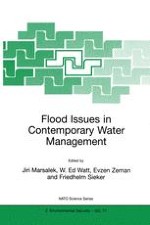2000 | OriginalPaper | Buchkapitel
Risk of Flood Levee Overflowing
verfasst von : M. Sowinski
Erschienen in: Flood Issues in Contemporary Water Management
Verlag: Springer Netherlands
Enthalten in: Professional Book Archive
Aktivieren Sie unsere intelligente Suche, um passende Fachinhalte oder Patente zu finden.
Wählen Sie Textabschnitte aus um mit Künstlicher Intelligenz passenden Patente zu finden. powered by
Markieren Sie Textabschnitte, um KI-gestützt weitere passende Inhalte zu finden. powered by
The uncertainty for hydraulic structures design can be divided into four basic categories: hydrologic, hydraulic, structural and social-economical. Hydraulic engineers are particularly interested in the first two categories. Traditional approach ignored the existence of hydraulic uncertainty assuming conveyance of the hydraulic structure as deterministic. Risk associated only with the natural randomness of hydrologic event was considered in terms of its return period. In order to integrate hydrologic and hydraulic uncertainties, two types of rateability models have been applied: static models and dynamic models [1]. Static models do not consider the repeated nature of hydrologic events e.g. floods. To this type belong models based on direct integration method [2,3,4,5], first-order second moments method (mean value and advanced) [6,7] and Monte Carlo simulation. Dynamic or time-dependent models can consider repeated application of loading. The objective of these models is to determine the reliability of a structure over a specified time interval (usually its service life) in which the number of occurrences of loading is a random variable. Almost all of types of models specified above were applied in the past to flood levee reliability analysis.
